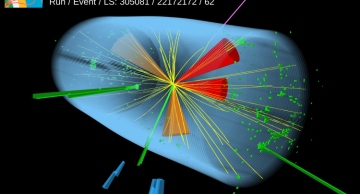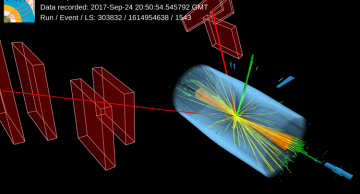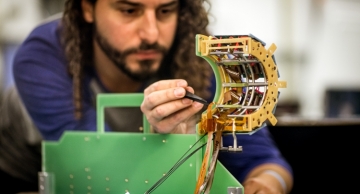During the early months of 2020, as the COVID-19 threat increased, CMS activity was adapted to gradually transfer responsibility to locally resident collaborators. LS2 work was accelerated in the experimental hall, so as to reach a critical LS2…
News
|
fblekman |
Physics
The CMS Collaboration announced the first observation of a new way the B0s meson – a particle combining the beauty quark (b) and the strange quark (s) – can disintegrate. The observation involves two other particles, the well-known ϕ meson…
|
fblekman |
Physics
Identification of muons is essential for the physics done at the LHC. CMS has recently published a paper with new techniques to identify muons with high momentum. What is so special about muons with high momentum that they deserve a dedicated paper…
|
fblekman |
Physics
The CMS collaboration has achieved the first observation of a ttH process in a single Higgs boson decay channel. The Higgs boson is examined in its decay to two photons when produced alongside a top quark and antiquark. This enables the…
|
fblekman |
Physics
The CMS collaboration has examined for the first time the kinematic dependence of the production of a top quark and a W boson. This gives insight into the quantum interference of top quark production at the LHC and allows more accurate…
|
fblekman |
Physics
To investigate when the Standard Model will start breaking down, the CMS Experiment looks at extremely rare collisions where the Large Hadron Collider is working as a boson-boson collider. This can teach us more about the nature of the…
|
fblekman |
Physics
New, undiscovered charged particles could be produced by the LHC, leaving tracks in CMS that look similar to tracks from Standard Model particles. If the new particle decays to other, unseen new particles inside the CMS tracker, a very striking…
|
fblekman |
Physics
Nowadays, artificial neural networks have an impact on many areas of our day-to-day lives. They are used for a wide variety of complex tasks, such as driving cars, performing speech recognition (for example, Siri, Cortana, Alexa), suggesting…
|
fblekman |
Physics
At the LHC, protons do not collide one at a time. Instead, the protons are combined into bunches, packages of more than 100,000 million (1011) protons. These bunches are then pointed at each other at the four collision points of the LHC. Even when…
|
plujan |
Detector
When the LHC is sending billions of protons at each other millions of times per second, it’s important to know just how many of them actually are colliding, both so that the LHC can optimize its operations to produce the most collisions possible,…
|
kkaadze |
Detector
Soon after 2027, the LHC will enter the high luminosity era, known as HL-LHC, during which it is expected to deliver about 20 times more data than delivered up the end of Run 2.
In order to achieve such high luminosity, the LHC is going to use…
|
fbaldass |
Collaboration
2019 is approaching its end with it the first year of the LHC Long Shutdown 2 (LS2),a break that focuses on the upgrade and maintenance of the LHC. It’s been twelve intense months for the growing CMS collaboration that counts 53 member countries.…












